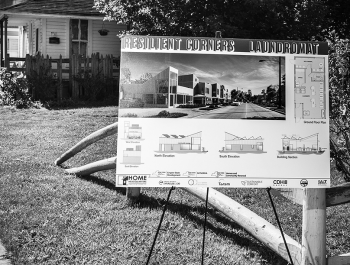Image

Kerry P. Quaglia, Executive Director, Home HeadQuarters
Challenge: Nearly a century of regrettable public policies, including large-scale urban renewal, highways that cut through urban centers, have impoverished the SALT District of Syracuse, NY. The area suffers from a transient residential population, high crime rates and entrenched poverty.
In Syracuse, NY, the SALT District is located in the Near Westside neighborhood, adjacent to the western edge of the city’s downtown urban core. Although this neighborhood appears geographically central, it is separated by a six-lane highway on the eastern edge and an old railroad embankment on the northern border. Where once booming industries employed workers from this neighborhood, old abandoned warehouses line the gateway to the area. During the 1930’s, the neighborhood was redlined, making it impossible for mortgages to be backed and stalling any additional investment in the neighborhood. For more than 80 years, the SALT District and the larger Near Westside neighborhood have suffered from severe disinvestment.
The SALT District is one of the city’s most culturally diverse and economically distressed neighborhoods. According to the American Community Survey data, of the 1,887 residents, 37 percent are black, 39.9 percent are white and 44.9 percent are Hispanic. One-third of the population over the age of five speaks Spanish as their primary language. This is significant in because Hispanics make up only 8 percent of the city’s total population. The median household income in the SALT District is $12,799 and the neighborhood’s poverty rate is an alarming 65 percent, nearly double that of the city’s rate.
The lack of wealth can be seen in the neighborhood’s deteriorating housing stock where 12.8 percent of the housing units stand vacant. The latest Census data highlighted the neighborhood’s owner-occupancy rate at only 10.3 percent. Even with significant financial and human capital invested from Home HeadQuarters (HHQ) through real estate development subsidies, commercial, first mortgage and home improvement financing and asset based planning activities and from their partners including, Syracuse University, the Near Westside Initiative and Syracuse Center of Excellence in Energy and Environmental Systems (Syracuse CoE) residents continue to lag behind other parts of the city in economic prosperity and affordable housing opportunities.
 Despite all of its challenges, the neighborhood has several key assets that are encouraging and spurring renewal and growth. The housing ranges from smaller one-story cottages, to large Italianate style buildings, to structures that offer mixed-use opportunities. The large number of vacant lots creates opportunities for new construction, increased yard space for existing residents, and/or off street parking. The Syracuse Housing Authority has an apartment complex with approximately 469 rental units. Small neighborhood businesses offer experiences and products that highlight the cultural roots of people who live in the area.
Despite all of its challenges, the neighborhood has several key assets that are encouraging and spurring renewal and growth. The housing ranges from smaller one-story cottages, to large Italianate style buildings, to structures that offer mixed-use opportunities. The large number of vacant lots creates opportunities for new construction, increased yard space for existing residents, and/or off street parking. The Syracuse Housing Authority has an apartment complex with approximately 469 rental units. Small neighborhood businesses offer experiences and products that highlight the cultural roots of people who live in the area.HHQ’s project is part of a comprehensive neighborhood plan centered on the idea that for it to thrive, an area of concentrated poverty has to transform to a neighborhood where families across a range of incomes are willing to live. The project will bring two market rate units and two rentals at fair market plus six additional affordable single-family homes. This infusion of new residents from across the income spectrum will help de-concentrate the poverty in this area. The project is also designed to provide sustainable energy and other commercial services to improve the marketability and long-term health of the neighborhood.
In 2016, with their partners – Syracuse CoE and the Near Westside Initiative – HHQ will undertake its "resilient corners" project where they will build a geothermal district that will service eight new LEED rated single-family homes and a "green" community laundry facility that will use solar to heat the water. It will also build two new LEED rated single-family “Live-Work” homes and undertake the substantial rehab of a commercial building where they have two commercial units and two rental units. The goal is to create a mix of homeownership and rental opportunities that will attract diverse residents to the SALT District.
This project will lead to immediate and long-lasting reductions in greenhouse gas emissions through the redevelopment of underutilized and vacant properties of three street corners in the SALT District. It relies on sustainable building practices already implemented in the neighborhood and uses smart planning principles including infill re-development, diversity of land use and proximity to employment, community assets and public transportation. It also encourages sustainable housing development including LEED housing design, the installation of green construction principles and green infrastructure improvements.
The SALT District is greener now than it was just five years ago, thanks in large part to the efforts of HHQ and their partners the Near Westside Initiative, Syracuse University, Syracuse Center of Excellence in Energy and Environmental Systems (Syracuse CoE), and the cooperation of neighborhood residents.
These community engagement efforts have created a vibrant road map for redevelopment and success in this neighborhood in particular.
This project illustrates the following lessons:
- collaboration with many partners with different strengths and resources is key to the success of a project
- sustainable and green building practices greatly add to the quality of the development and the health and well-being of the neighborhood
- bringing in new residents with a range of income helps to revitalize the neighborhood which in turns increases its marketability.

